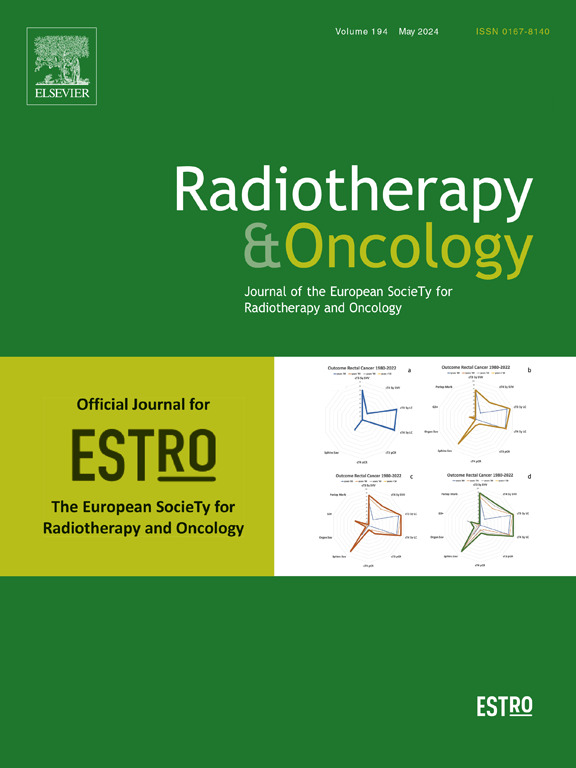Impact of estimated dose of radiation to immune cells (EDRIC) in locally advanced Non-Small-Cell lung Cancer: A secondary analysis of the multicenter randomized PET-Plan trial
IF 4.9
1区 医学
Q1 ONCOLOGY
引用次数: 0
Abstract
Purpose
A higher estimated dose of radiation to immune cells (EDRIC) has been proposed as an explanation for failed attempts at thoracic radiation intensification as a part of concurrent chemoradiotherapy (cCRT) for locally advanced non-small-cell lung cancer (NSCLC), as lymphopenia in particular is a negative prognostic factor in this context. We studied the impact of EDRIC on survival in this secondary analysis of the prospective PET-Plan trial (ARO-2009–09; NCT00697333). Considering the immune system as an organ at risk for radiotherapy is of major importance in the current era of consolidation immunotherapy.
Methods
Eligible patients had previously received chemoradiotherapy up to 60–74 Gy with radiation treatment planning based on an 18F-FDG PET/CT targeting all CT positive lymph nodes plus 50 Gy elective nodal irradiation (arm A) versus targeting only PET-positive nodes (arm B). EDRIC was calculated with the original model by Jin et al. in addition to a modified score with cohort-specific weight parameters.
Results
Sufficient data were available in 153 patients with a median follow-up time (95 % confidence interval [CI]) of 41.6 (34.6 − 53.7) months. Using the original model, the mean EDRIC (range) was 5.70 (3.23 − 8.44) Gy and showed a strong inverse correlation with PFS (hazard ratio [HR] = 1.77; 95 % CI 1.23–2.54; p = 0.002) and OS (HR = 1.72; 95 % CI 1.12–2.65; p = 0.01). The mean modified EDRIC (range) was 5.30 (3.01 − 8.38) Gy, again with a strong inverse correlation with PFS (HR = 1.66; 95 % CI 1.16–2.38; p = 0.006) but not OS (HR = 1.40; 95 % CI 0.91–2.15; p = 0.122). Neither radiation treatment allocation (arm A vs. B) nor technique (3D-CRT vs. IMRT) influenced EDRIC (p = 0.889 and p = 0.958, respectively) and EDRIC did not influence the rate of early or delayed hematological toxicity. On multivariate analysis, mean body dose (MBD) was the main contributing factor of the EDRIC equation to PFS and OS.
Conclusion
Higher doses of radiation to the immune system were associated with worse PFS in this secondary analysis of the PET-Plan trial. The omission of elective nodal irradiation did not influence EDRIC. MBD could potentially suffice as a surrogate for EDRIC, as it is more readily available and requires fewer calculations. Future trials should aim to refine existing models and investigate ways to reduce EDRIC to limit its effects in patients undergoing cCRT for locally advanced NSCLC.
估计辐射剂量对局部晚期非小细胞肺癌免疫细胞(EDRIC)的影响:多中心随机PET-Plan试验的二次分析
目的更高的免疫细胞放射剂量(EDRIC)被认为是局部晚期非小细胞肺癌(NSCLC)同步放化疗(cCRT)中胸部放射强化尝试失败的原因,因为淋巴细胞减少在这种情况下是一个负面的预后因素。我们在前瞻性PET-Plan试验(ARO-2009-09;NCT00697333)。在当前的巩固免疫治疗时代,考虑到免疫系统是一个有放射治疗风险的器官是非常重要的。方法符合条件的患者先前接受了高达60-74 Gy的放化疗,放疗计划基于18F-FDG PET/CT靶向所有CT阳性淋巴结加上50 Gy选择性淋巴结照射(A组),而仅靶向PET阳性淋巴结(B组)。EDRIC是Jin等人在原始模型的基础上加上一个带有特定队列权重参数的修改评分计算出来的。结果153例患者获得了足够的数据,中位随访时间(95%置信区间[CI])为41.6(34.6 ~ 53.7)个月。使用原始模型,平均EDRIC(范围)为5.70 (3.23 ~ 8.44)Gy,与PFS呈强负相关(风险比[HR] = 1.77;95% ci 1.23-2.54;p = 0.002)和OS (HR = 1.72;95% ci 1.12-2.65;p = 0.01)。修正后的平均EDRIC(范围)为5.30 (3.01 ~ 8.38)Gy,与PFS呈强烈的负相关(HR = 1.66;95% ci 1.16-2.38;p = 0.006),但无OS (HR = 1.40;95% ci 0.91-2.15;p = 0.122)。放疗分配(A组vs. B组)和技术(3D-CRT vs. IMRT)均不影响EDRIC (p = 0.889和p = 0.958分别),EDRIC不影响早期或延迟血液学毒性的发生率。在多变量分析中,平均体剂量(MBD)是EDRIC方程对PFS和OS的主要影响因素。结论:在PET-Plan试验的二次分析中,对免疫系统的高剂量辐射与较差的PFS相关。选择性淋巴结照射的省略对EDRIC没有影响。MBD可以作为EDRIC的替代品,因为它更容易获得并且需要更少的计算。未来的试验应旨在完善现有的模型,并研究减少EDRIC的方法,以限制其对局部晚期NSCLC接受cCRT患者的影响。
本文章由计算机程序翻译,如有差异,请以英文原文为准。
求助全文
约1分钟内获得全文
求助全文
来源期刊

Radiotherapy and Oncology
医学-核医学
CiteScore
10.30
自引率
10.50%
发文量
2445
审稿时长
45 days
期刊介绍:
Radiotherapy and Oncology publishes papers describing original research as well as review articles. It covers areas of interest relating to radiation oncology. This includes: clinical radiotherapy, combined modality treatment, translational studies, epidemiological outcomes, imaging, dosimetry, and radiation therapy planning, experimental work in radiobiology, chemobiology, hyperthermia and tumour biology, as well as data science in radiation oncology and physics aspects relevant to oncology.Papers on more general aspects of interest to the radiation oncologist including chemotherapy, surgery and immunology are also published.
 求助内容:
求助内容: 应助结果提醒方式:
应助结果提醒方式:


